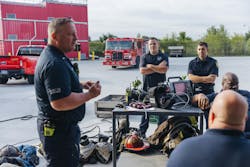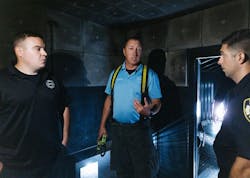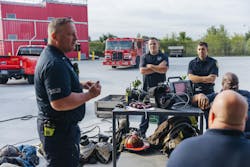Detroit Fire Department 165th Anniversary: Transformative Training
Key Takeaways
- Training that incorporates the best of traditional approaches and the latest innovative concepts results in better performance and outcomes in the field and higher firefighter morale.
- The success of the Detroit Fire Department’s advanced training evolutions wouldn’t be as great without its instructors’ recognition of the varied learning processes of the different personality types of those who are trained.
- Partnering with a community college allowed the Detroit Fire Department’s paramedic program to be authorized in a way that the program can be accredited.
Note: This article is part of Firehouse's Detroit Fire Department 165th Anniversary Special Section. To read the entire Special Section, click here.
Battalion Chief Eric Fett started with the Detroit Fire Department (DFD) in November 1992. The city of Detroit still operated under the Chapter 9 bankruptcy protection that it filed for 16 months earlier. Fire apparatus broke down regularly. Quality bunker gear and equipment and even basic station goods were in short supply. Line-of-duty injuries were on the rise.
“Firefighters came into work not knowing what to expect,” Fett says.
Today, nearly 11 years after the city emerged from bankruptcy and with the DFD having benefited in numerous ways because of that, Fett tells Firehouse that the agency is innovative rather than reactionary.
“If you told me back then that this department would be where it is today, I probably would have passed out,” he states.
Included in the innovation is the department’s revamping of its perspective and approach to training.
“We have access to great training now,” Fett says.
Of course, that means better performance and outcomes in the field. It also means high morale among members.
New perspective
Prior to the appointment of Chuck Simms as executive fire commissioner in 2023, the philosophy behind hiring/training might be described in terms of just filling boots. The standard is much higher today. This includes outfitting the Walter P. Harris Detroit Fire and Emergency Services Regional Training Center (RTC) with cutting-edge technology and training props, including for live structure fire training, BLEVE (Boiling Liquid Expanding Vapor Explosion) training, live automobile fire training, aircraft rescue and fire fighting (ARFF) training, and hazmat training. A new training tower and a partnership with General Motors that provides the DFD with insight that’s utilized in its electric vehicle (EV) fire training also are new to the mix.
Critical as these and other facilities and know-how are, the department’s training wouldn’t be as successful as it is without an understanding of the very people who are trained. Because instructors work with cadets, new hires, veterans of the department and members from outside agencies, a one-size-fits-all approach to instruction isn’t possible.
“When you’re an instructor, you have to read the crowd,” Battalion Chief Sam Vazquez stresses.
Lt. Stephen Ogrodowski adds that DFD training was built out in the past five years in ways that might not even have been conceived previously. This affords even professional development training, including leadership and management, for firefighters nationwide as well as elements that apply to the department’s ISO rating.
“We built into our schedule a three-day training that takes care of the 18-hour requirement for the facilities training,” Second Deputy Commissioner Derek Hillman says regarding the latter.
Dramatic shift
As noted in “Change of Direction” (page XX), an important part of the DFD’s evolution recently is implementation of its Medical First Responder program. This established that all firefighters be trained to EMT level to be able to provide basic medical care to Code 1 response victims. Initially, the DFD brought in outside experts to provide the training. However, soon after, having locked in on what was required, the department installed its own experts and system to facilitate all of the training internally.
Says Vazquez, “Firefighters should know how to heal somebody once they pull them out of the fire.”
Invigorated by the city’s new penchant for progress, the DFD took its members’ medical prowess to the next level by instituting an annual in-house paramedic training program. The first class began in March 2025. The goal is to grow the number of ALS-qualified units.
The class meets five days per week. It condenses what normally would take 18–24 months into 10 months, to allow students to achieve 500 hours of classroom instruction and 600 hours of clinical practice, to pass the national certification examination.
Because an advanced paramedic class must be accredited by the Committee on Accreditation of Educational Programs for the EMS Professions, the DFD partnered with the Wayne County Community College District (WCCCD). This enabled DFD’s RTC to become an authorized WCCCD alternate education center. An additional benefit to DFD members who pass the class is that they achieve college credits that can apply to an associate degree in applied science.
Unlike some circumstances in which firefighters who pursue their paramedic certification must learn on their own time and at their own expense, the DFD compensates existing EMT-certified firefighters for their training while on duty. An important element behind the decision was the DFD finding that it and other agencies in the state of Michigan were losing staff because of the hardship that was put on members to pay for the training themselves and devote time out of their personal life.
Simms has called the move a game-changer.
“We are creating opportunities for the Detroit Fire Department from within,” he said in a statement to introduce the program. He described the program as strengthening the department workforce and accelerating the DFD’s capability to provide ALS service to the public when they need it most. “It’s not just training; it’s transformation.”
Among the best
Whether in regard to the improved and expanded fire training or the EMT and paramedic training, Simms, Ogrodowski and others find that the vast majority of members have bought in.
“Overall, it was pretty much nothing but excitement and investment from all of our EMS personnel and fire personnel,” Ogrodowski tells Firehouse.
The DFD now considers itself a leading force in the fire service and EMS training world, and it results from a shift in philosophy about how training should be handled. It requires a strong foundation, doing whatever is necessary to ensure that everyone is on the same page, and allocating funds in ways that weren’t explored previously because the funding wasn’t available.
About the Author
Rich Dzierwa
Managing Editor, Firehouse Magazine
Rich Dzierwa joined Firehouse Magazine in 2019 after four tenures with other publications. He was editor-in-chief of Consumers Digest/ConsumersDigest.com and of trade magazine Cutting Tool Engineering. He served as the consumer products reporter for BridgeNews and began his publishing career with an 11-year tenure at Appliance magazine, where he rose to managing editor after serving in other roles. Dzierwa's experience with consumer products, including furnishings, appliances, electronics and space design, has transferred to his Firehouse work regarding the magazine's Station Design columns and the Station Design Awards. Previous work also has contributed to his supervision of several surveys of fire service/EMS members, to produce unique reporting for Firehouse's audience. Dzierwa earned a bachelor's degree in English from Columbia College Chicago.

Ryan Baker
Ryan Baker is a writer and associate editor with prior experiences in online and print production. Ryan is an associate editor for Firehouse with a master's degree in sciences of communication from the University of Wisconsin-Whitewater. He recently completed a year of teaching Intro to Public Speaking at UW-Whitewater, as part of his graduate program. Ryan acquired his bachelor's degree in journalism in 2023 from UW-Whitewater, and operates currently out of Minneapolis, MN. Baker, also writes freelances for the Ultimate Frisbee Association (UFA) in his free time, while also umpiring baseball for various ages across the Twin Cities Metro Area.



